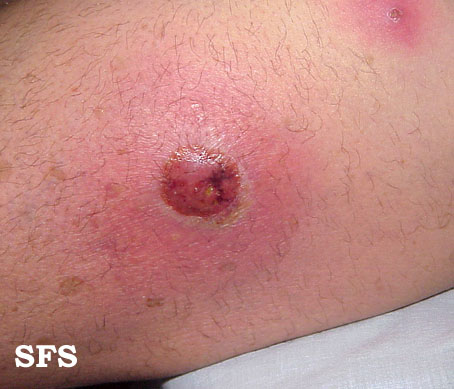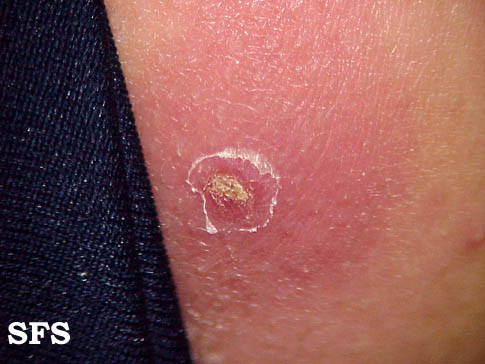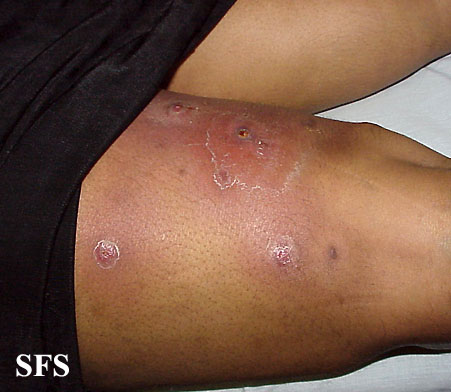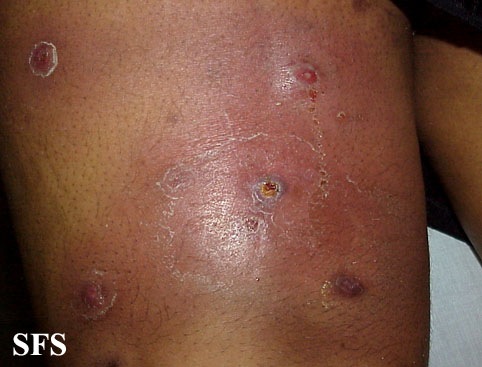Boil overview
|
Boil Microchapters |
|
Diagnosis |
|---|
|
Treatment |
|
Case Studies |
|
Boil overview On the Web |
|
American Roentgen Ray Society Images of Boil overview |
Editor-In-Chief: C. Michael Gibson, M.S., M.D. [3]; Associate Editor(s)-in-Chief: Yamuna Kondapally, M.B.B.S[4]Jesus Rosario Hernandez, M.D. [5]
Overview
Boil or furuncle is a skin disease caused by the inflammation of hair follicles, thus resulting in the localized accumulation of pus and dead tissue. Individual boils can cluster together and form an interconnected network of boils called carbuncles. In severe cases, boils may develop to form abscesses.
Historical Perspective
Staphylococcus aureus was discovered in late 1870's by Alexander Ogston, a surgeon at the Aberdeen Royal Infirmary. It was discovered to be the major cause of skin and soft tissue infections such as boils, staphylococcal scalded skin syndrome and impetigo[1] [2]. Carl Alois Philipp Garrè was a Swiss surgeon who proved that Staphylococcus aureus causes carbuncles and boils by self experimentation. Dr. Garre discovered and named Garre's sclerosing osteomyelitis (sclerosing osteitis – form of chronic osteomyelitis with proliferative periostitis).[3]
Classification
Boil (furuncle) may be classified according to the International Classification of Diseases (ICD-10) based on anatomical location.[4] Based on the duration of symptoms, boils may be classified into acute and chronic.
Pathophysiology
Boil (furuncle) is a localized deep suppurative necrotizing form of folliculitis which involves the dermis and the subcutaneous tissue. Staphylococcus aureus is the most common causative agent. Following an abrasion or cut, the pathogen uses the wound site to invade and colonize the hair follicle. This leads to the formation of tender, erythematous, perifollicular nodule. The boil later becomes painful and fluctuant leading to discharge of pus and formation of necrotic plugs, which may leave a scar.[5]
Causes
Boils (furuncles) are generally caused by an infection of the hair follicles by Staphylococcus aureus or Staphylococcus epidermidis.
Differentiating Boil overview from Other Diseases
Boil (furuncle) must be differentiated from other common diseases that cause tender swelling or a reddened lump filled with pus such as cystic acne, hydradrenitis suppurativa, and pilonidal cyst.[6]
Epidemiology and Demographics
The incidence and prevalence of boils (furuncles) is uncertain. In England, between 2002-2003, boils and carbuncles were responsible for approximately 190 out of 100,000 hospital visits[7]. Patients with all age groups can develop boils(furuncles). Boils(furuncles) is common among teenagers and young adults.
Risk Factors
Common risk factors in the development of boils include immunosupression, malnutrition, coexisting skin conditions, and poor hygiene.
Screening
According to the U.S. Preventive Service Task Force (USPSTF), there is insufficient evidence to recommend routine screening for furunculosis.
Natural History, Complications, and Prognosis
If left untreated, patients with boils (furuncles) may progress to develop carbuncles, fever, and lymphadenopathy. The most common complications of boils include scarring and recurrence. Other complications include septicemia leading to abscess of spinal cord, brain, kidneys, or other organs. The prognosis is generally good, however, it varies with underlying risk factors.
Diagnosis
History and Symptoms
A detailed and thorough history from the patient is necessary. Specific areas of focus when obtaining a history from the patient include history of immunosupression, family history of furunculosis, history of contact sports, history of close contact, and recent travel. Common symptoms of the boil include firm, red, and painful bump with pus filled head.[8][9][8]
Physical Examination
Patients with boils usually appear normal. However, the appearance varies with the associated risk factors.
Images
The following are the images associated with boils on extremities.
Laboratory Findings
Laboratory study which is consistent with the diagnosis of boils include the pus culture.
Imaging Findings
X ray may be performed to detect internal abscess and osteomyelitis.
Other Diagnostic Studies
Other diagnostic studies of boils include blood analysis, urine analysis, and biopsy.
Treatment
Medical Therapy
The mainstay of therapy for mild furuncles is incision and drainage only. Antimicrobial therapies are indicated in moderate and severe furuncles. Empiric antimicrobial therapies for furuncle include either TMP-SMX or Doxycycline for moderate furuncles, and either Vancomycin, Daptomycin, Linezolid, Telavancin, or Ceftaroline for severe furuncles.[10][11]
Surgery
Incision and drainage is indicated if the boil is deep large and persistent despite medical therapy.[12]
Prevention
Primary prevention
Effective measures for primary prevention of boils include hand washing, antibacterial soaps, maintain proper hygiene (hand sanitizers, antiseptic washes), avoid close contact (homeless shelters, military, prisons).
Secondary prevention
Secondary prevention strategies following boils are warm moist compresses on the boil, hand washing, and proper wound care.
References
- ↑ Methicillin resistant staphylococcus aureus. National institute of allergy and infectious diseases(2016) https://www.niaid.nih.gov/topics/antimicrobialresistance/examples/mrsa/Pages/history.aspx Accessed on August 12,2016
- ↑ Boil. London review of books. http://www.lrb.co.uk/v27/n24/hugh-pennington/dont-pick-your-nose accessed on August 12,2016
- ↑ Wikipedia. CarlGarre(boil). https://en.wikipedia.org/wiki/Carl_Garr%C3%A9 Accessed on August 12,2016
- ↑ ICD-10 Diagnosis Codes Index. http://icdlist.com/icd-10/index/cutaneous-abscess-furuncle-and-carbuncle-l02 Accessed on August 4,2016
- ↑ Ibler KS, Kromann CB (2014). "Recurrent furunculosis - challenges and management: a review". Clin Cosmet Investig Dermatol. 7: 59–64. doi:10.2147/CCID.S35302. PMC 3934592. PMID 24591845.
- ↑ Boil(furuncle)(2016).https://en.wikipedia.org/wiki/Boil Accessed on August 9, 2016.
- ↑ Statistics about boil. Right diagnosis(2015). http://www.rightdiagnosis.com/b/boil/stats.htm Accessed on August 12,2016
- ↑ 8.0 8.1 Stevens, Dennis L., et al. "Practice guidelines for the diagnosis and management of skin and soft-tissue infections." Clinical Infectious Diseases 41.10 (2005): 1373-1406.
- ↑ MedlinePlus https://medlineplus.gov/ency/article/001474.htm August 1,2016 Accessed on August 10,2016
- ↑ Gilbert, David (2015). The Sanford guide to antimicrobial therapy. Sperryville, Va: Antimicrobial Therapy. ISBN 978-1930808843.
- ↑ Boils(furuncle). MedlinePlus(2016). [1] Accessed on August 11,2016
- ↑ Boils(furuncle). MedlinePlus(2016). [2] Accessed on August 11,2016





